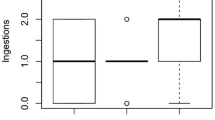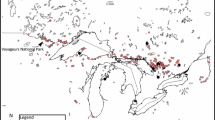Summary
We conducted laboratory experiments to test the hypothesis that rotifers could coexist with small (<1.2 mm) but not large (>1.2 mm) cladocerans. Keratella cochlearis was excluded in <8 days by the large cladocerans Daphnia pulex and D. magna, probably through both interference and exploitative competition. On the other hand, K. cochlearis persisted for 8 weeks with two small cladocerans (Bosmina longirostris and Ceriodaphnia dubia) and excluded a third small cladoceran (D. ambigua). Similarly, Synchaeta oblonga coexisted with B. longirostris for >7 weeks, and K. testudo coexisted with D. ambigua for >4 weeks. Coexistence of small cladocerans and rotifers was always accompanied by suppression of one or both populations, probably primarily if not exclusively by exploitative competition for limiting food resources. These results indicate that the competitive dominance of cladocerans over rotifers decreases markedly with cladoceran body size and that factors other than body size may determine the competitive outcome between rotifers and small cladocerans. Our study provides a mechanistic explanation for a commonly observed pattern in natural zooplankton communities: planktonic rotifers often are abundant when only small cladocerans occur but typically are rare when large cladocerans are present.
Similar content being viewed by others
References
Andersson G, Berggren H, Cronberg G, Gelin C (1978) Effects of planktivorous and benthivorous fish on organisms and water chemistry in eutrophic lakes. Hydrobiologia 59:9–15
Bengtsson J (1987) Competitive dominance among Cladocera: are single factors enough? Hydrobiologia 145:245–250
Brooks JL, Dodson SI (1965) Predation, body size, and composition of plankton. Science 150:28–35
Burns CW, Gilbert JJ (1986) Effects of daphnid size and density on interference between Daphnia and Keratella cochlearis. Limnol Oceanogr 31:848–858
DeMott WR (1983) Seasonal succession in a natural Daphnia assemblage. Ecol Monogr 53:321–340
DeMott WR, Kerfoot WC (1982) Competition among cladocerans: nature of the interaction between Bosmina and Daphnia. Ecology 63:1949–1966
Gilbert JJ (1985) Competition between rotifers and Daphnia. Ecology 66:1943–1950
Gilbert JJ (1988) Suppression of rotifer populations by Daphnia: a review of the evidence, the mechanisms, and the effects on zooplankton community structure. Limnol Oceanogr 33:1286–1303
Gilbert JJ, MacIsaac HJ (1989) The susceptibility of Keratella cochlearis to interference from small cladocerans. Freshwater Biol (in press)
Gilbert JJ, Stemberger RS (1985) Control of Keratella populations by interference competition from Daphnia. Limnol Oceanogr 30:180–188
Goulden CE, Hornig LL (1980) Population oscillations and energy reserves in planktonic Cladocrea and their consequences to competition. Proc Nat Acad Sci (USA) 77:1716–1720
Goulden CE, Henry LL, Tessier AJ (1982) Body size, energy reserves, and competitive ability in three species of Cladocera. Ecology 63:1780–1789
Gurevitch J, Chester ST Jr (1986) Analysis of repeated measures experiments. Ecology 67:251–255
Hall DJ, Threlkeld ST, Burns CW, Crowley PH (1976) The size-efficiency hypothesis and the structure of zooplankton communities. Ann Rev Ecol Syst 7:177–208
Hrbáček J (1962) Species composition and the amount of zooplankton in relation to fish stock. Rozpravy Ceskoslovenske Akademie Ved Rada Matermatickych a Prirodnick Ved 72:3–116
Kerfoot WC, DeMott WR (1985) Interactions among cladocerans: food limitation and exploitative competition. Arch Hydrobiol 21:431–451
Kirk KL (1988) The effect of suspended sediments on planktonic rotifers and cladocerans. Doctoral thesis, Dartmouth College, Hanover, New Hampshire, USA
Lynch M (1979) Predation, competition, and zooplankton community structure: an experimental study. Limnol Oceanogr 24:253–272
Matveev V (1985) Competition and population time lags in Bosmina (Cladocera, Crustacea). Int Rev Ges Hydrobiol 70:491–508
Neill WE (1984) Regulation of rotifer densities by crustacean zooplankton in an oligotrophic montane lake in British Columbia. Oecologia 61:175–181
Neill WE (1985) The effects of herbivore competition upon the dynamics of Chaoborus predation. Arch Hydrobiol 21:483–491
Pace ML, Orcutt JD Jr (1981) The relative importance of protozoans, rotifers, and crustaceans in a freshwater zooplankton community. Limnol Oceanogr 26:822–830
Porter KG, Feig YS, Vetter EF (1983) Morphology, flow regimes, and filtering rates of Daphnia, Ceriodaphnia, and Bosmina fed natural bacteria. Oecologia 58:156–163
Romanovsky YE, Feniova IY (1985) Competition among Cladocera: effect of different levels of food supply. Oikos 44:243–252
Rothhaup KO (1988) Mechanistic resource competition theory applied to laboratory experiments with zooplankton. Nature 333:660–662
Ruttner-Kolisko A, Malicky G (1988) Succession and abundance of rotifers in Lunzer as determined by biological interactions and abiotic events. Verh Internat Verein Limnol 23:510–515
SAS (Statistical Analysis System) Institute (1985) User's Guide: Statistics Ed. 5 Cary, North Carolina, USA
Shapiro J, Forsberg B, Lamarra V, Lindmark G, Lynch M, Smeltzer E, Zoto G (1982) Experiments and experiences in biomanipulation. US Environmental Protection Agency EPA-600/ 3-82-096
Slobodkin LB (1954) Population dynamics in Daphnia obtusa Kurz. Ecol Monogr 24:69–88
Smith DW, Cooper SD (1982) Competition among Cladocera. Ecology 63:1004–1015
Sprules WG (1972) Effects of size-selective predation and food composition on high altitude zooplankton communities. Ecology 53:375–386
Stemberger RS (1981) A general approach to the culture of planktonic rotifers. Can J Fish Aquat Sci 38:721–724
Stemberger RS (1988) Reproductive costs and hydrodynamics benefits of chemically induced defenses in Keratella testudo. Limnol Oceanogr 33:593–606
Stemberger RS, Gilbert JJ (1984) Spine development in the rotifer Keratella cochlearis: induction by cyclopoid copepods. Freshwater Biol 14:639–647
Stemberger RS, Gilbert JJ (1985) Body size, food concentration, and population growth in planktonic rotifers. Ecology 66:1151–1159
Tessier AJ, Goulden CE (1987) Cladoceran juvenile growth. Limnol Oceanogr 32:680–686
Tessier AJ, Henry LL, Goulden CE, Durand MW (1983) Starvation in Daphnia: energy reserves and resource allocation. Limnol Oceanogr 28:667–676
Threlkeld ST (1976) Starvation and the size structure of zooplankton communities. Freshwater Biol 6:489–496
Tillmann U, Lampert W (1984) Competitive ability of differently sized Daphnia species: an experimental test. J Freshwater Ecol 2:311–323
Tilman D (1982) Resource competition and community structure. Princeton University Press, Princeton, New Jersey
Vanni M (1986) Competition in zooplankton communities: suppression of small species by Daphnia pulex. Limnol Oceanogr 31:1039–1056
Yan ND, Geiling W (1985) Elevated planktonic rotifer biomass in acidified metal-contaminated lakes near Sudbury, Ontario. Hydrobiologia 120:199–205
Author information
Authors and Affiliations
Rights and permissions
About this article
Cite this article
MacIsaac, H.J., Gilbert, J.J. Competition between rotifers and cladocerans of different body sizes. Oecologia 81, 295–301 (1989). https://doi.org/10.1007/BF00377074
Received:
Accepted:
Issue Date:
DOI: https://doi.org/10.1007/BF00377074




